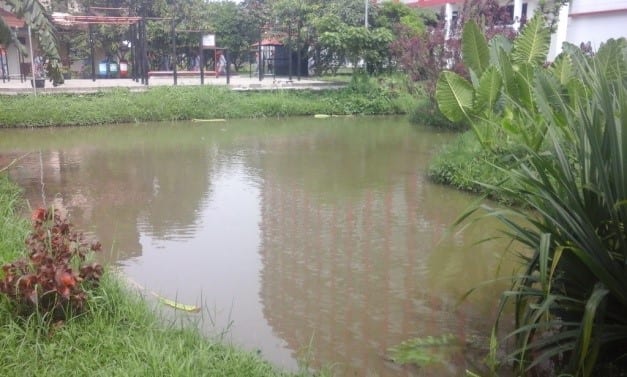Telkom University telah mengambil langkah signifikan dalam mewujudkan visi “Green Campus” melalui pembangunan kolam penampungan air hujan. Dengan lokasi strategis dan sistem yang terintegrasi, kolam ini tidak hanya berfungsi sebagai penampung air, tetapi juga sebagai bagian dari upaya pelestarian lingkungan yang lebih luas.
Lokasi Strategis dan Desain Kolam
Kolam penampungan air hujan di Telkom University dibangun di area belakang Gedung TUCH, yang merupakan pusat kegiatan utama kampus. Lokasi ini dipilih untuk memaksimalkan pengumpulan air hujan selama musim hujan. Dengan desain yang efisien, kolam ini mampu menampung aliran permukaan air hujan dan menyimpannya untuk berbagai kebutuhan kampus, seperti penyiraman taman dan kebutuhan non-konsumsi lainnya.
Selain kolam penampungan, kampus ini juga telah memanfaatkan teknologi biopori untuk mendukung pengelolaan air. Biopori adalah lubang resapan yang dibuat di tanah untuk mempercepat proses infiltrasi air ke dalam tanah. Dengan biopori, air hujan yang tidak tertampung di kolam tetap dapat terserap dengan baik ke dalam tanah, mengurangi risiko genangan, sekaligus menambah cadangan air tanah.
Sistem Filtrasi Modern
Untuk memastikan kualitas air yang terkumpul, Telkom University telah memasang sistem filtrasi modern di kolam ini. Sistem ini berfungsi untuk membersihkan air hujan dari kotoran dan zat berbahaya sebelum digunakan. Dengan demikian, air yang disimpan di kolam tidak hanya aman tetapi juga berkualitas tinggi.
Manfaat Bagi Lingkungan dan Kehijauan Kampus
Penggunaan kolam penampungan air hujan memberikan manfaat besar bagi lingkungan kampus. Air yang terkumpul digunakan untuk mengairi tanaman di area taman, sehingga mengurangi ketergantungan pada sumber air tanah. Selain itu, penggunaan biopori artinya juga mendukung upaya pelestarian lingkungan. Manfaat biopori termasuk meningkatkan kemampuan tanah dalam menyerap air, mencegah erosi, dan memperbaiki struktur tanah dengan mendukung aktivitas mikroorganisme.
Kombinasi kolam penampungan dan biopori memberikan dampak positif ganda: menjaga kualitas tanah sekaligus mendorong keberlanjutan ekosistem lokal.
Meningkatkan Kesadaran Lingkungan
Pembangunan kolam penampungan air hujan dan penerapan biopori juga berfungsi sebagai sarana edukasi bagi mahasiswa dan staf. Kampus secara aktif menyelenggarakan program pendidikan tentang pentingnya pengelolaan air hujan, biopori, dan praktik berkelanjutan lainnya. Dengan cara ini, Telkom University tidak hanya menciptakan infrastruktur hijau tetapi juga membangun budaya kesadaran lingkungan di kalangan komunitas akademik.
Kontribusi terhadap Keberlanjutan Global
Inisiatif ini merupakan bagian dari komitmen Telkom University terhadap keberlanjutan global. Dengan mengadopsi praktik pengelolaan air yang baik, termasuk pemanfaatan biopori, kampus ini tidak hanya memberikan manfaat bagi lingkungan lokal tetapi juga menjadi contoh bagi institusi pendidikan lainnya. Melalui langkah inovatif seperti pembangunan kolam penampungan air hujan dan penerapan teknologi biopori, Telkom University berkontribusi pada pelestarian sumber daya air dan menciptakan masa depan yang lebih berkelanjutan untuk generasi mendatang.
Kesimpulan
Pembangunan kolam penampungan air hujan di Telkom University, ditambah dengan pemanfaatan biopori, merupakan langkah penting dalam mewujudkan kampus hijau yang berkelanjutan. Dengan sistem yang efisien, inovasi teknologi, dan komitmen terhadap pendidikan lingkungan, kampus ini menunjukkan bahwa tindakan kecil dapat memberikan dampak besar bagi pelestarian lingkungan. Manfaat biopori dan kolam penampungan air hujan menjadi bukti nyata bahwa pengelolaan sumber daya air yang baik dapat menciptakan ekosistem yang seimbang dan berkelanjutan. Diharapkan inisiatif ini terus berkembang dan menginspirasi banyak institusi pendidikan lain untuk mengadopsi praktik berkelanjutan yang serupa.


Leave a Reply